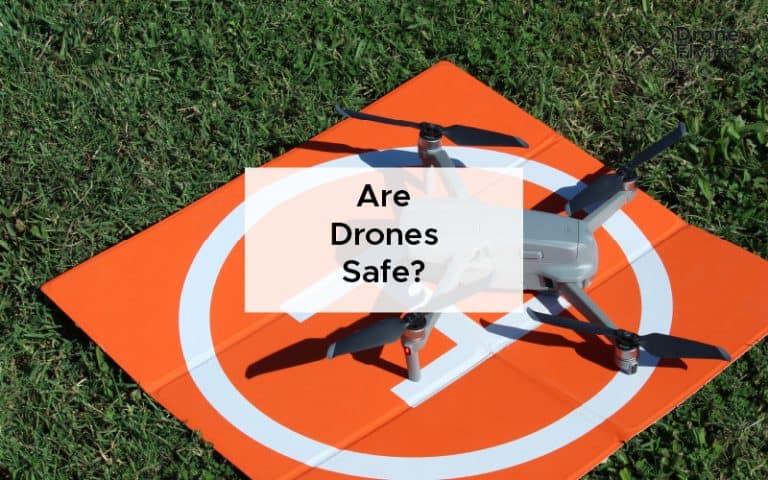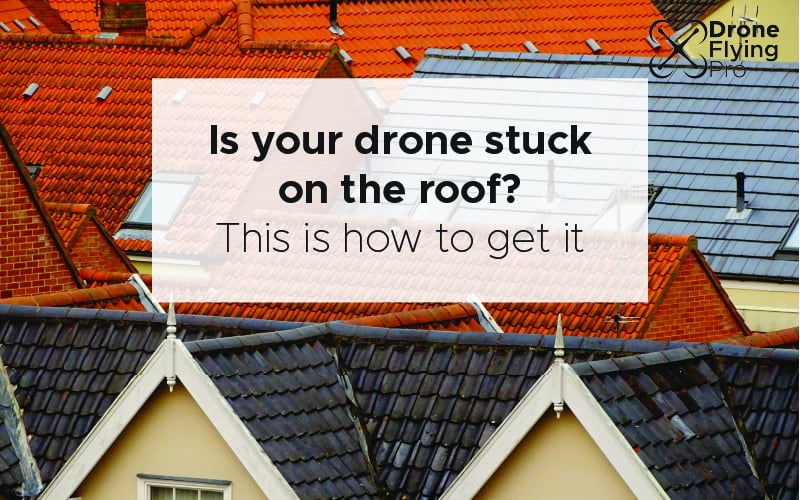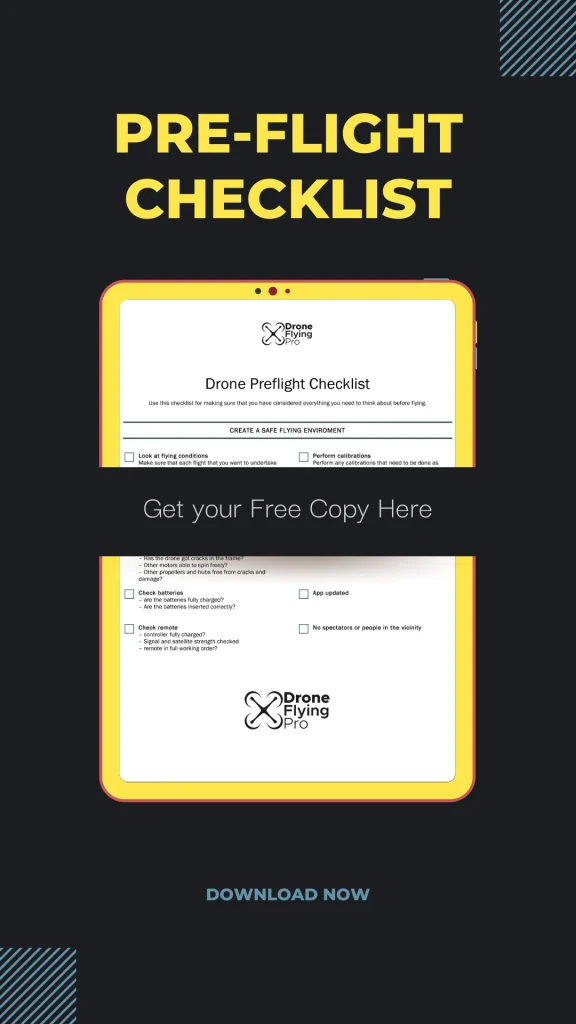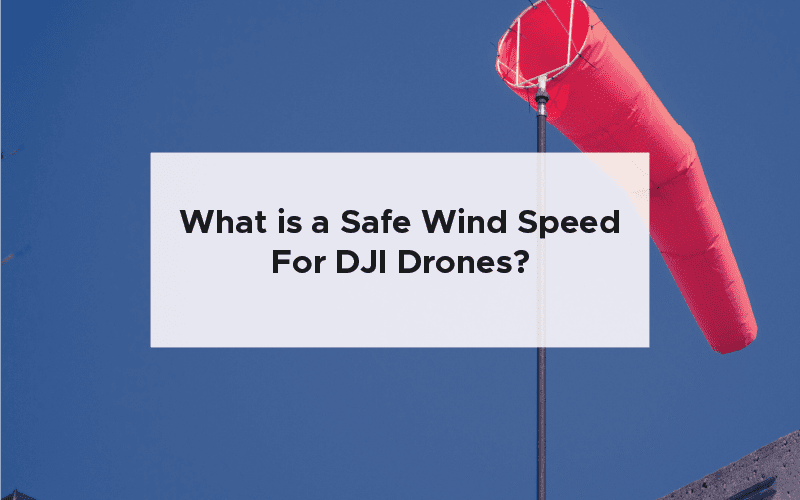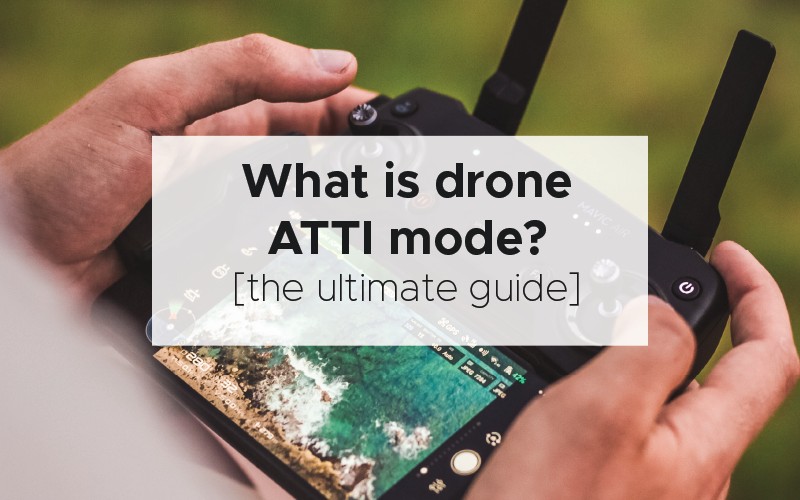Drones can seem inherently unsafe. They fly above us at incredible heights and speeds, and the smallest of problems can cause the drone to come tumbling down. There are many rules and regulations in every jurisdiction in which drones are allowed. Make sure that you follow these rules and the majority of the hazards associated with flying a drone are removed.
Unlike other forms of aviation, the accidental fatality rate for drones is zero. Nearly 900,000 drones are registered in the US, and the overall accident rate is in the order of hundreds per year. That makes drone flying very safe.
Drones are safe if you follow the law in the country you are flying, keep your drone in good condition and perform pre-flight checks to ensure a safe flight.
When you are first learning to fly a drone, it can be intimidating to understand all of the different controls and exactly what you should do in an emergency.
As you fly more often and the number of flight hours you accumulate increases, you will be able to understand when you should and should not fly a drone and the limits of a particular drone model.
Are drones safe to fly?
Drones are very safe to fly.
Many commercially available drones have a variety of safety features built into the drone, which means that you can fly them safely. Manufacturers include safety features such as:
- automatic hovering – taking your hands off of the joystick means that many drones will hover in place until they automatically return home because of low battery.
- Return to home – many drones will automatically return home at the push of a button. They are also starting to evolve and return to home even when there are obstacles in the way of their flight path.
- 360° obstacle avoidance – as drone technology becomes more affordable, manufacturers include more and more sensors to avoid collisions. Many modern drones have 360° sensing abilities.
- Smart obstacle avoidance – we expect drones to make more and more decisions as they fly. Drones can now fly home whilst avoiding every obstacle in their path. Even thin overhanging branches are no longer a problem.
Drones will get safer and safer as they become more and more advanced. Furthermore, legislation has taken a while to catch up to drone technology.
The evolution of drone law
In December 2020, the FAA issued rules requiring remote identification for drones. This digital license plate will broadcast the identity of the drone and its control station.
Other new rules went into effect on April 2021, stating that small drones are now allowed to fly over people, moving vehicles and at night under certain conditions. Other rules will be rolled out over the next few years, and we can expect the legal drone landscape to evolve to keep drones and their owners safe.
Each country will slowly hone in on the most important drone laws for keeping its citizens safe.
It will likely involve much more legislation and accountability for drone pilots. This new accountability will likely involve registration, licensing, and further education for the drone community.
Examples of the accidents that have occurred
Here is a table of a select number of drone incidents grouped into the incident type.
| Type of Incident | Examples |
| Collision with building | Drone crashes into Leaning Tower of Pisa |
| Drone crashed into Brighton i360 | |
| Falling out of the sky | Matrice Pro enters manual mode |
| Two hurt during event | |
| Filming Sport | Football matched stopped |
| Match stopped | |
| Illegal drone footage of match | |
| Accidents retrieving drone | Men electrocuted retrieving drone |
| Near airports | Drone too close to LAX |
| Too close to plane at UK airport | |
| Logan Airport Near miss | |
| Near Glasgow airport | |
| Drone near Auckland airport |
You will notice from this table that it is very rarely the hardware or software of a drone that fails. Many of the incidents are due to pilots flying in a no-fly zone such as stadiums and airports. Or pilot error such as flying into a building.
Retrieving a drone from a crash can be a very risky endeavour as the drones could end up near power lines, like the above example, or on roofs that pose a falling risk.
What we can learn from these accidents
We can learn from these incidents that pilot error decisions to fly in no-fly zones are the main reasons accidents happen. The technology inside the drone is very robust, and there are many failsafes to ensure that the drone returns home safely.
Learn how to fly in manual mode
Learning to fly your drone manually without GPS assisted stabilisation features will be the ultimate way to ensure that you can control your drone at all times.
The incident of a GPS compass error mentioned in the table highlights how important it is to be able to fly your drone in high winds without the advantage of GPS stabilisation.
When a GPS-compass problem prompted the aircraft to revert to a manual flight mode, it was used to survey a building site in an automated flight mode. By the time the pilot and observer realised it wasn’t responding to the return-to-home (RTH) function, the aircraft had drifted beyond a line of trees, and the visual line of sight had been lost. It then slammed with a house’s roof before crashing into the property’s back yard. There were no injuries.
Here is an image of the drone’s path after entering manual flight mode.
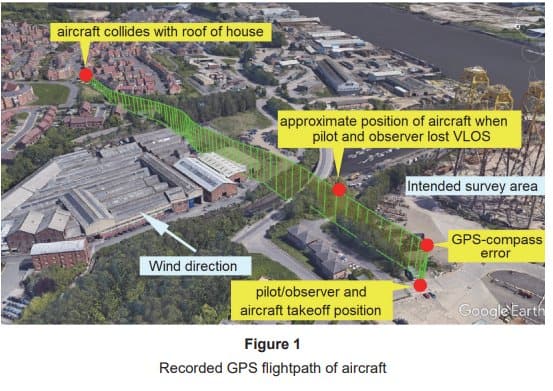
Do not rely on return to home
As pilots, we should ensure that we do not rely on returning home at the end of our flight mission. It is important that we can navigate back to the landing spot without using the return to home feature.
I always return my drone to the takeoff spot using the first person live video stream and line of site navigation. Having the skills is imperative for keeping your drone flight safe.
Stay away from no-fly zones
Of all of the incidents that can cause significant damage to property and people, flying near airports is the riskiest.
Suppose you are a recreational user of drones. In that case, you can now utilise the FAA drone app, which was developed in collaboration with the business Aloft (previously known as Kitty Hawk), to find out where you can and cannot fly.
This app gives recreational (hobby) flyers, drone enthusiasts, and pilots situational awareness. It’s accessible on Apple’s App Store and Google’s Play Store for Android phones.
It also comes with a desktop version, which you may use to perform some pre-flight preparation and research.
Do not collect your drone from dangerous areas
Another way you can stay safe while flying your drone is to ensure that you do not collect your drone from risky areas.
Drones are an expensive gadget, and the loss of the drone is something that a lot of drone pilots would hate to happen.
If your drone ends up crash landing in a dangerous place, the above table shows us that a serious threat to life can occur if you are near power lines or operating in a similarly dangerous place.
Stay in visual line of sight
Many countries and regulations demand that you keep a visual line of sight to your drone at all times. If you’re flying in fog or other low-visibility conditions, you won’t be able to see your drone at close range.
Always make sure that you stay in visual contact with your drone to ensure that you can see if your drone is away from obstructions and to ensure that you are not flying away from the takeoff spot when you are returning home.
How to stay safe
Staying safe with your drone involves doing the right thing from the moment you decide to go out on your flight mission. Make sure that you fly in the right place, check the drone and the battery for condition and quality, and calibrate the drone if required.
Learning how to read the weather and wind conditions and understanding the limits of your drone model will allow you to fly safely and securely in any situation.
Fly in the right place
Flying your drone in the right place means that you will not attract the attention of the police.
Sometimes there is an amazing place where you want to fly your drone. Unfortunately, sensitive areas and 5 km restricted zones around the airport sometimes mean that you cannot fly your drone and have to stick to ground-based photography.
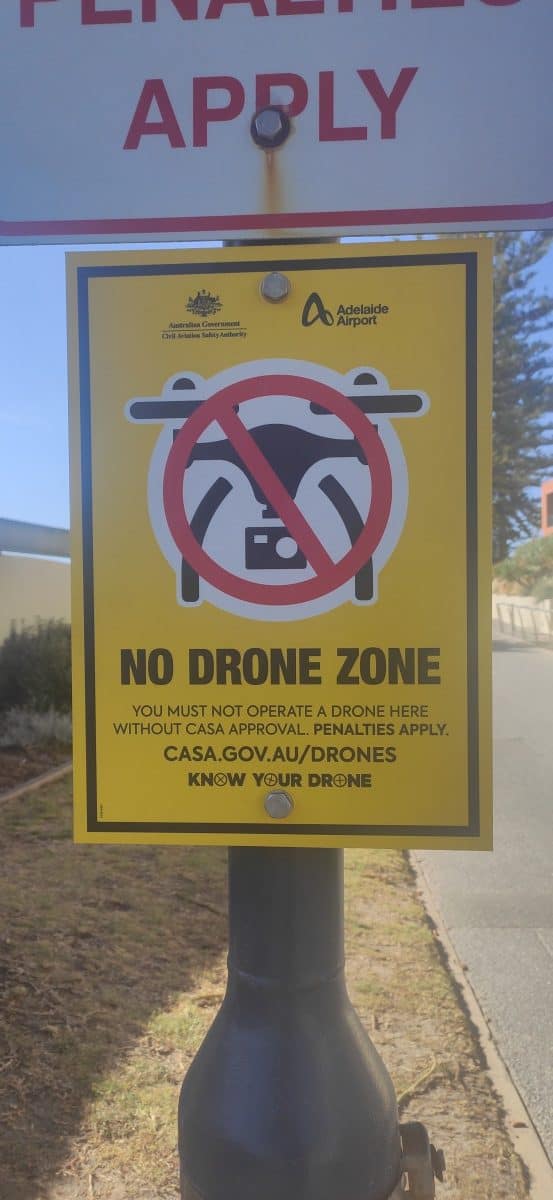
I have noticed more and more that no drone signage has been placed around my local area. This is frustrating as the parklands around Adelaide provide some amazing opportunities to capture footage. Nonetheless, I will always abide by the rules as they keep me and others safe.
Using and downloading an app that uses data from authoritative sources, you may quickly determine where you can and cannot fly. I prefer open sky, but these are the best alternatives for the future.
OpenSky App
In the United States, Australia, and other parts of the world, OpenSky works wonderfully.
It’s a straightforward and easy-to-understand method of looking at drone rules and regulations so you may fly with confidence no matter where you are.
It’s a free tool that allows you to organise flights for various drone users, and you can learn about local rules and restrictions by typing in a specific address.
The FAA and CASA in Australia have certified Open Sky as a supplier of real-time access to regulated airspace information.
Drone operators can apply for permission to operate in controlled airspace, including areas near major cities. It automatically monitors airspace laws and regulations and notifies you when the airspace is clear for flying.
Check the drone and battery
Making sure that your drone is in safe working order is a fantastic way of keeping your drone safe.
Checking the body of the drone and the battery for any signs of damage before taking off will ensure a safe flight for everyone.
Important things you should check before flying your drone:
- condition of propellers
- free and smooth movement of motors
- no cracks in arms
- no cracks in the frame of the drone
- the remote-controlled joysticks are firm and in position
- the USB cable is free from cracks
- the USB connector sits firmly in your phone, and your remote
- batteries are all charged – on both the drone and the remote control.
Download this as a pre-flight checklist for you to print off.
Calibrate the drone (if required)
Calibrating your drone is very important for keeping your drone safe. Calibrating your drone ensures that its sensors will provide accurate information to the artificial intelligence that keeps your drone lying safely.
Throughout a regular flight, your drone can experience vibrations and collisions that can throw off the calibration of drone components.
Regular calibration will keep it in perfect operating condition.
If your drone prompts you to calibrate a certain portion of your hardware, you should do this as a matter of urgency. It is very common for drones to require compass calibration before every flight.
As soon as your drone is flying, a rule of thumb for all drone pilots is to hover at around 3 to 5 metres, check for stability, and ensure that it operates exactly as you expect it to. If it doesn’t, land the drone and re-calibrate the compass and anything else that has just received a caution message.
Get all the qualifications required
It is important to get all of the qualifications and license that you need to fly in your country.
Each country has its geography and weather patterns that will be discussed during any training you go through.
Even though this may feel like a bit of a pain in the bum, it is important to abide by all rules and regulations, even if you feel like you can get away with flying without going through the appropriate bureaucratic processes.
Check the weather
If you’re planning to fly your drone along the coast, pay close attention to the weather and how it will vary during your journey.
There are many excellent resources for checking the weather, and a simple Google search of your flight location can yield a 24-hour prediction that is reasonably accurate.
You should also verify the nautical information and the general weather conditions. This information includes details such as surge size and wave quality, as well as an estimate of how much wind to expect throughout your trip.
It would help if you never flew in gusts exceeding two-thirds of your drone’s maximum speed. Check out my other article for a thorough overview on a safe wind speed for DJI drones – click here for a complete rundown.
As drone flights become longer (because of improved battery technology), you’ll need to check for a one-hour window for each battery. Because you’re near the seaside, the weather can change suddenly, and wind gusts can drain your drone’s battery quickly.
Make sure you understand how the weather will change during the time at the location.
Learn how to fly manually
Lastly, it is important to learn how to fly manually.
For whatever reason, drones may automatically decide to turn off advanced flying features such as auto-hover, GPS location fixing, and other different types of safety features.
For example, the DJI drone can turn itself into ATTI mode. The GPS sensors are disabled in this mode, and the obstacle avoidance sensors will also be turned off. To find out more about ATTI mode, check out my other article – click here.
Learning to maintain your altitude and fly back to the takeoff position is a skill that will save you should you find yourself in a manual flying situation. Purchasing a cheaper drone will allow you to practice without the comforts of the GPS location and flying software.
Can a drone hurt you?
Should the worst happen, a drone collision with a person can cause significant and serious injury.
Whilst a drone cannot cut off your finger, it can cause lacerations to soft tissue, and science has even shown that the plastic plates of a drone spinning at high numbers of revolutions per second can cause quite serious damage.
Researchers from Aalborg University in Denmark have studied the damage produced by various propellers. They’ve been utilising them to harm pork in various ways (as it is one of the closest things to human muscle and skin). They then applied the propellers to other materials such as glass and automobiles.
The researchers fastened a huge piece of pork to the end of a ramp. The ramp was utilised to direct the blades towards the meat while rotating at exact RPMs.
The catapult itself is almost three metres long and made of aluminium. An electric motor is used to pull the slide. It can accelerate a 1-kilogram drone up to 15 metres per second, and the collision is captured on film using a high-speed camera capable of recording over 3000 frames per second.
Here is some very interesting footage of the science experiment:
The force of impact is assessed over time because the extent of the injury depends on it. The goal is to update the catapult as the researchers gain more experience, allowing for larger drones and faster speeds.
The final word
This article has been through everything you need to know about whether or not drones are safe.
The take-home message is that the technology of a drone very rarely fails and causes accidents. Most accidents are due to pilot error and to fly in areas where they should not be flying.
Properly maintaining your drone and ensuring that it is in good working order will allow you to fly safely. Also, abiding by all of the different rules and regulations in your country will keep the drone flight as safe as possible.
